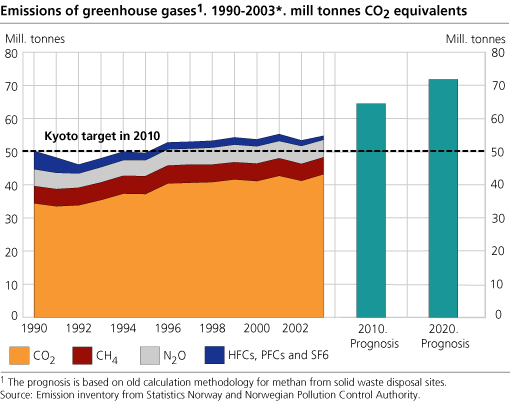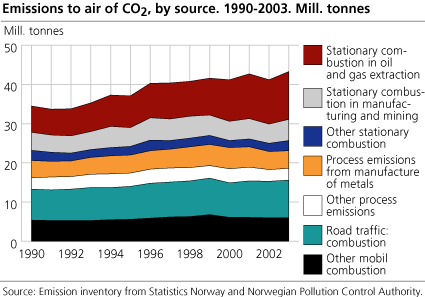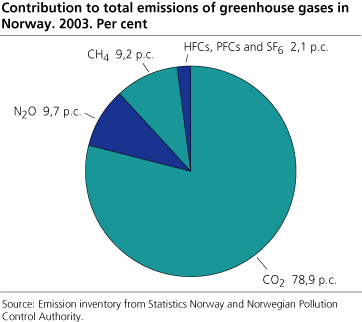Content
Published:
This is an archived release.
9 per cent rise in greenhouse gas emissions since 1990
Reduced activity in parts of the manufacturing industry in 2002 resulted in reduced emissions of greenhouse gases that year. In 2003, however, the emissions increased by 1.3 million tonnes or 2.5 per cent. The emissions of CO2 alone rose by 5 per cent, while there was a small decrease in emissions of other greenhouse gases.
Total Norwegian emissions of greenhouse gases in 2003 amounted to nearly 55 million tonnes, which is 9 per cent higher than in 1990. In 2003, the growth was 1.3 million tonnes CO2 equivalents. The calculations are carried out by Statistics Norway and the Norwegian Pollution Control Authority. Preliminary figures for 2003 were first published in April 2004.
Greenhouse gases include carbon dioxide (CO2), methane (CH4), nitrous oxide (N2O), hydrofluorocarbons (HFCs), perfluorocarbons (PFCs) and sulphur hexafluoride (SF6). While aggregate emissions of CH4, N2O, HFCs, PFCs and SF6 were reduced by 25 per cent in the period 1990-2003, the CO2 emissions increased by 26 per cent in the same period. This gas alone accounted for 79 per cent of the greenhouse gas emissions in 2003 compared with 69 per cent in 1990. The increased CO2 proportion and the reduction of the other gases are due to growth in the CO2 emissions as well as a reduction in emissions of the other gases because of environmental measures or technological improvements.
In 2003, the emissions of CO2 were 5 per cent or 2 million tonnes higher than the previous year. Increased combustion of natural gas on the continental shelf and increased use of fossil fuels in manufacturing industries and other industries contributed to the main bulk of this growth. There was a considerable rise in emissions from diesel cars and from coastal traffic.
and oil and gas activity contributed most
Most of the greenhouse gas emissions in 2003 came from combustion of natural gas for electricity production on the continental shelf. The energy-demanding production of natural gas increased by 11 per cent, which resulted in increased CO2 emissions from the oil and gas industry. The emissions from oil refineries, gas terminals and the petrochemical industry also rose due to higher activity levels.
The total energy consumption in 2003 remained on level with 2002, but high electricity prices at the beginning of the year led to increased use of fuel oil for heating and industrial purposes. This generates direct CO2 emissions.
Reduced emissions from industrial processes
Greenhouse gas emissions from aluminium production dropped in 2003 despite higher production of aluminium. This was possible because increased use of prebaked technology and improved control of the processes led to reduced emissions of PFCs by 400 000 tonnes CO2 equivalents.
Nitrous oxides from manufacture of commercial fertilizer also dropped as a result of technological improvements.
Methane emissions down
Emissions of methane in 2003 were 1 per cent lower than in 2002. The most important sources of methane are landfills and agriculture. Emissions from landfills have been reduced by 17 per cent from 1990. A new calculation method in the methane emission model contributes to lower emissions from landfills than previous calculations suggest.
Process emissions from agriculture accounted for 39 per cent of the methane emissions in 2003.
Other greenhouse gases are also reduced
Emissions of nitrous oxides have been reduced due to improved control of the processes.
The reduction in emissions of SF6 is attributable to the closure of a production plant for primary magnesium in 2002. Emissions of HFCs showed a decline in 2003 after several years of growth. HFCs replace gases that are harmful to the ozone layer.
The Kyoto commitment
The Kyoto Protocol enters into force in February 2005, after Russia ratified the protocol at the end of 2004. According to the protocol, Norway's emissions of greenhouse gases in the period 2008-2012 must not be more than 1 per cent higher than the 1990 level. Quotas (emission credits) can be bought from other countries in order to reach the target (Kyoto mechanisms).
New emission figures
Other emission figures also being published: Emissions to air of NOX, NMVOC and ammonia and Emissions to air of persistent organic pollutants and heavy metals .
Read more about emissions to air:
NOS Emissions to air 1973-2003
State of the Environment Norway
See more emission figures in StatBank .
Tables:
This page has been discontinued, see Emissions to air, Annually.
Contact
-
Trude Melby Bothner
E-mail: trude.melby.bothner@ssb.no
tel.: (+47) 40 81 14 25
-
Berit Storbråten
E-mail: berit.storbraten@ssb.no
tel.: (+47) 40 81 14 23



